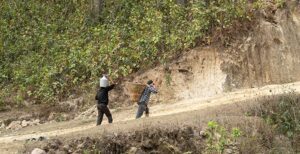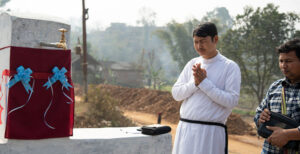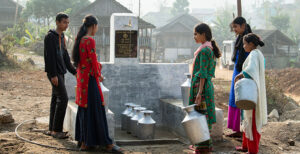Raise funds for Clean Water
There are many ways you can fundraise, whether it’s a bake sale, a marathon, or a party!
This website will offer limited functionality in this browser. We only support the recent versions of major browsers like Chrome, Firefox, Safari, and Edge.

The trip to and from the water source was laborious and time consuming. The time Harleigh (pictured, right) spent gathering water he could have spent earning money.
The reason Pastor Oisin and the group of volunteers from his church were so intent on digging was simple: The village needed water. Clean, pure water, not the muddied and filthy water sources they were used to. Even this dirty water did not provide for all their needs; the well was usually not full in the summertime, from March till June.
“When the dry season starts … the [water] level goes so much down that people sometimes get inside the well and collect the water,” says Pastor Oisin.
Pastor Oisin’s village faces severe water scarcity, much as a good portion of the world does. According to the United Nations, around 2 billion people lack sufficient access to safely managed drinking water services.
But the villagers in Pastor Oisin’s area need water for more than just drinking.
“They need water for drinking, water for cooking, and they even need water for [the] toilet,” the pastor explains, “… They also have animals and cattle they have to give water to.”
“During the months of March, April, May and June … we face acute water scarcity.”
If they could grow crops, they would use the water for that, too.
However, limited by their water supply, the villagers couldn’t grow any crops. With the inadequate amount of water they drew per day, growing vegetables simply wasn’t feasible, even though it would have saved them money and trips to the market.
Another issue was the time it took the villagers to gather water. Many spent hours each day collecting the vital resource, walking back and forth multiple times to bring home only enough for their essential needs. The main problem, however, remained: The water source of the village had no filter. It was contaminated.
Pastor Oisin mentions that the villagers often fell ill, diarrhea being one of the more prevalent issues. The contaminated well, however, was the only one the villagers could use.
“We have a lot of water problems here in this place,” Elouise, a resident of the village and leader of the village, says. “During the months of March, April, May and June … we face acute water scarcity.”
According to Elouise, if the village doesn’t get enough rain before those months, collecting water gets even harder. Once the local water source dries up, the villagers have to walk farther and farther away from the village. There is only one river in the area, but reaching it takes time, so it is used only when nearly every other water source has dried up. Elouise remembers when a severe drought struck the village around six years ago.
“We had to even in that year to walk up a [nearby] river,” she says, “which is around one hour just to walk and reach there … two hours for just one pot of water.”
It was for these reasons that the pastor wanted to drill a Jesus Well. And his congregation wanted to help. In fact, they wanted to do the work themselves. After receiving both permission and funds, Pastor Oisin gathered a number of volunteers from his church, and they got to work. But it didn’t take long for the team to run into problems—multiple, rocky problems.
“We were praying, ‘Lord, You promised that You will bring rivers in the desert … and You are going to give water when we dig, no matter how hard the ground is.’”
After only two feet of digging, Pastor Oisin and the believers encountered more rocks than dirt. At first, the rocks were a nuisance, but the farther the team dug, the larger the rocks became. Soon they had turned into boulders, boulders Pastor Oisin and his team could not handle by themselves. They would need stronger tools to go further.
In the end, they hired a driller and excavator to help finish the process. When other villagers saw all the effort that was going into the well, they expressed their doubts. There was no way the believers would find water, they said. The area was full of stones, not dirt. The church members were wasting their time and money.
At first, it seemed the villagers were right. Pastor Oisin had to call up the driller twice to get past unwieldy stones in an effort to find water. At one point, the driller refused to drill further.
In the face of failure and discouragement, the believers did not despair.
“We were praying, ‘Lord, You promised that You will bring rivers in the desert,’” Pastor Oisin recalls, “‘and You are going to give water when we dig, no matter how hard the ground is.’”
Once they got the drill operator to resume drilling for a time, the pastor and believers waited and prayed. Around the 25-foot mark, their prayers were answered. The drill had hit wet soil.

Pastor Oisin dedicates the new Jesus Well, finally built after much hard labor.
Some villagers remained skeptical. A well would need a lot more water than that to supply them, they said. The driller agreed and left, but Pastor Oisin and the believers were not deterred. They continued to have faith that God would provide and began digging again, along with some hired workers. They dug another 8 feet, finally stopping at the 33-foot mark when they hit an 8-foot deep pocket of water—more than enough to help supply the village. God had answered the believers’ prayers.
Upon the well’s completion, the benefits immediately became clear. Elouise is happy that there now exists a readily available clean source of water. With the new well, Elouise says, things will be much easier, especially if another drought strikes.
“In five, six minutes I can come here and fetch water,” she says. And Elouise isn’t the only one happy with the shortened time gathering water.
“It is a great joy for us to see that the Jesus Well is just in front of our house,” says Harleigh, another resident of the village and elder of the church. “Gone are those days that we had to walk for several hours to fetch water.”
With the saved time, Harleigh will be able to work on other things, namely earning more money through sewing clothes. But, saving time also means saving energy.
“In two minutes, I can fetch the water,” Lilian, another villager says. “[The well] saves my time, it saves my energy, and I can do a lot other work because I don’t have to spend time bringing water from far places.”

Villagers immediately gather to collect clean water from their new Jesus Well.
Right now, nearly 122 million people worldwide use untreated surface water for their daily needs, and 368 million collect their water from unprotected wells and springs. But GFA pastors like Oisin work to ensure the communities they serve can have access to the clean water they need. And you can be part of that. Partner with us to help other families like Elouise’s, Harleigh’s and Lilian’s drink clean water.
There are many ways you can fundraise, whether it’s a bake sale, a marathon, or a party!